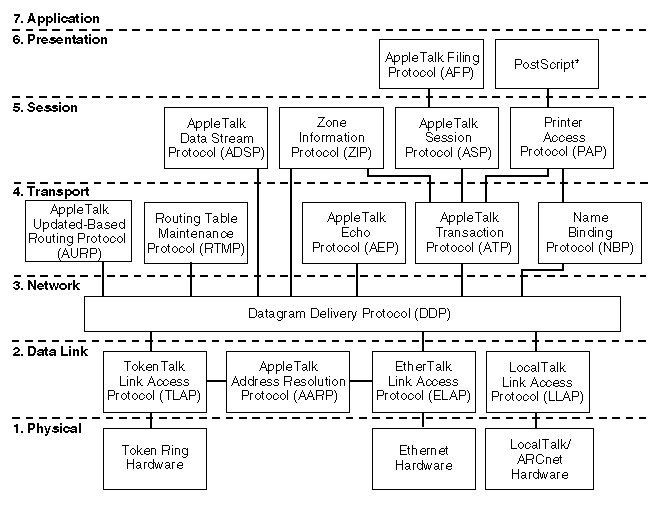

  |
The AppleTalk for NetWare protocols provide connectivity and routing to NetWare networks. These protocols work together with NetWare for Macintosh to provide AppleTalk print and file service features on a NetWare server, as well as the communication between network nodes.
Figure 1 represents the standard AppleTalk protocols and their ISO layers, as described in Inside AppleTalk, Second Edition .
Figure 1
AppleTalk Protocol Layers
Table 1 lists the AppleTalk protocols used by the Novell Internet Access Server 4.1 routing software. The table also describes what each protocol does. For more detailed information about these protocols, refer to Inside AppleTalk, Second Edition .
Table 1. AppleTalk Protocols
| Protocol | Description |
|---|---|
AARP |
AppleTalk Address Resolution Protocol. AARP maps AppleTalk addresses (network and node numbers) into LAN hardware addresses (for example, Ethernet or token ring addresses), and manages the process of each AppleTalk node acquiring its unique AppleTalk address on these media. |
ADSP |
AppleTalk Data Stream Protocol. ADSP enables two programs to communicate through a full-duplex data stream connection in which either program can read or write data bytes with reliable delivery. |
AEP |
AppleTalk Echo Protocol. AEP is a support protocol that provides a way for a node to bounce a packet off another node. Novell Internet Access Server 4.1 supports the AppleTalk Echo Protocol. |
AFP |
AppleTalk Filing Protocol. AFP is an Application-level support protocol that enables Macintosh users to share files. NetWare for Macintosh includes an AFP NetWare Loadable Module (NLMTM) file that provides AFP support on a NetWare server. |
ASP |
AppleTalk Session Protocol. By enabling two processes to exchange a sequence of transactions reliably, ASP works with and adds session functionality to ATP (described below). |
ATP |
AppleTalk Transaction Protocol. ATP provides reliable request and response transaction services. By detecting errors and timeouts, ATP provides reliable packet exchange. |
AURP |
AppleTalk Update-based Routing Protocol. AURP provides two unique features: the exchange of routing information only when a change occurs on the internetwork (instead of exchanging the information on a set schedule), after the initial exchange of routing information, and IP tunneling. AURP uses the UDP transport protocol in the TCP/IP protocol suite. See AppleTalk Update-Based Routing Protocol for more information. |
DDP |
Datagram Delivery Protocol. DDP defines sockets on AppleTalk nodes and defines datagram (packet) delivery between sockets. It provides a mechanism to address any node on an AppleTalk internetwork uniquely. |
LAP |
Link Access Protocol. LAP includes Data-Link level protocols for Ethernet (ELAP), LocalTalk* (LLAP), and token ring (TLAP). LAP hides media-specific information from the other layers of AppleTalk and sends packets onto a specific hardware link. |
NBP |
Name Binding Protocol. NBP provides lists of service names to a user and finds the network addresses of these names. When users request an AppleTalk service in the Macintosh Chooser application, NBP is responsible for broadcasting the request in the selected zone and displaying the names of responding services in the Chooser. See Name Binding Protocol for more information about NBP. |
PAP |
Printer Access Protocol. PAP enables users to access printers or print queues on the AppleTalk network. |
RTMP |
Routing Table Maintenance Protocol. Routers use RTMP to exchange information they need to build and maintain their routing tables. This enables routers to discover each other and move packets from one point on an internetwork to another. AppleTalk routers on the internetwork that use RTMP continuously maintain their routing tables by exchanging RTMP packets. See Routing Table Maintenance Protocol for more information. |
ZIP |
Zone Information Protocol. ZIP associates zone names with network numbers and uses queries to maintain this mapping when new zones are added to an internetwork. AppleTalk uses zones to subdivide the internetwork logically so that services are easier for users to find. Routers use ZIP to request and provide zone information when a router comes up with a new network configuration. ZIP also enables nodes to look up and deal with the zones on an internetwork. See How Zone Information Is Maintained on an Internetwork for more information. |
The following protocols are especially important in AppleTalk routing:
  |